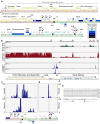Characterization of mycobacteriophage Adephagia cytotoxic proteins
- PMID: 39031590
- PMCID: PMC11373665
- DOI: 10.1093/g3journal/jkae166
Characterization of mycobacteriophage Adephagia cytotoxic proteins
Abstract
Mycobacterium phage Adephagia is a cluster K phage that infects Mycobacterium smegmatis and some strains of Mycobacterium pathogens. Adephagia has a siphoviral virion morphology and is temperate. Its genome is 59,646 bp long and codes for one tRNA gene and 94 predicted protein-coding genes; most genes not associated with virion structure and assembly are functionally ill-defined. Here, we determined the Adephagia gene expression patterns in lytic and lysogenic growth and used structural predictions to assign additional gene functions. We characterized 66 nonstructural genes for their toxic phenotypes when expressed in M. smegmatis, and we show that 25 of these (38%) are either toxic or strongly inhibit growth, resulting in either reduced viability or small colony sizes. Some of these genes are predicted to be involved in DNA metabolism or regulation, but others are of unknown function. We also characterize the HicAB-like toxin-antitoxin (TA) system encoded by Adephagia (gp91 and gp90, respectively) and show that the gp90 antitoxin is lysogenically expressed, abrogates gp91 toxicity, and is required for normal lytic and lysogenic growth.
Keywords: cytotoxic genes; mycobacteriophage; toxin–antitoxin.
© The Author(s) 2024. Published by Oxford University Press on behalf of The Genetics Society of America.
Conflict of interest statement
Conflicts of interest The author(s) declare no conflicts of interest.
Figures




References
-
- Amaya I, Edwards K, Wise BM, Bhattacharyya A, Pablo CHD, Mushrush E, Coats AN, Dao S, Dittmar G, Gore T, et al. 2023. A genome-wide overexpression screen reveals Mycobacterium smegmatis growth inhibitors encoded by mycobacteriophage Hammy. G3 (Bethesda). 13(12):jkad240. doi: 10.1093/g3journal/jkad240. - DOI - PMC - PubMed
-
- Dedrick RM, Abad L, Storey N, Kaganovsky AM, Smith BE, Aull HA, Cristinziano M, Morkowska A, Murthy S, Loebinger MR, et al. 2023a. The problem of Mycobacterium abscessus complex: multi-drug resistance, bacteriophage susceptibility and potential healthcare transmission. Clin Microbiol Infect. 29(10):1335.e9–1335.e16. doi: 10.1016/j.cmi.2023.06.026. - DOI - PMC - PubMed
MeSH terms
Substances
Grants and funding
LinkOut - more resources
Full Text Sources
Molecular Biology Databases
